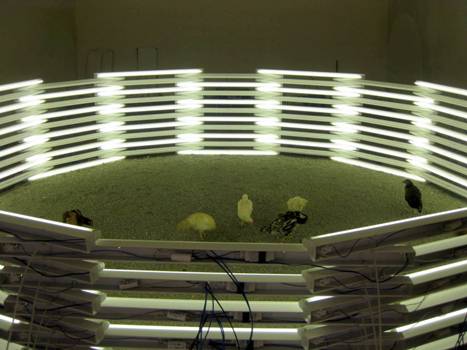Centro de Arte Contemporáneo Wilfredo Lam,
Mar 27, 2009 - Apr 30, 2009
La Habana Vieja, Cuba
10th Havana Biennial
by Pily Estrada and Christian León
Yoan Capote, who works with the materiality and psychology of objects, exhibited two exquisite pieces with subtle dissonances between them. Open Mind is a model that recreates a brain-shaped labyrinth where a series of swarming little bronze men reside. Secreto (mente cerrada) [Secret (closed mind)] consists of a glass tube sealed with two plugs, each ending in the shape of an ear facing inwards. They can only hear each other, but paradoxically there is no space for the production of sound. María Elvira Escallón presented the photographic series Cultivos [Crops] as part of the ambitious Estado de coma [State of Coma] project. Using interventions, photographs and videos, the project comments tenderly and ironically on the calamitous state of the San Juan de Dios Hospital in Bogotá. The series is made up of several ghostly photographs of bed out of whose mattress and pillow a lawn has grown. Elia Alba, continuing with her exploration of printed masks, exhibited a dozen busts made out of photographs that were assembled and sewn together. The gallery of crudely assembled, tortured, sinister faces creates the effect of a volumetric, convex Cubist work. For his part Rafael Trelles, working as part of the Laboratorio Artístico de San Agustín (LASA), made a series of interventions in public space by affixing images of the inhabitants of a Havana neighborhood on facades using stencils and jets of water. José Emilio Fuentes provides different reflections in Memoria & Memory, on which we will comment further below.
Maps and Geopolitics
In line with the Biennial’s theme, the cartographic, geographic and statistical representations that help visualize global cultural, economic and social exchanges were the order of the day. In Shores of a River, the Japanese artist Satomi Matoba digitally manipulates fragments of a world map to create new neighborhoods between distant cities and geographies. In O mundo alinhado [Aligned World] the Brazilians Angela Detanico and Rafael Lain manipulate a world map through black lines drawn on an LCD that bring to mind the lines of a text or barcodes, in a subtle reference to the geopolitical and economic fluctuations that transform map realism into graphic fluctuations associated with power. In contrast with this exercise in pure abstraction, María Victoria Portelles imagines the most perfect map possible. Summarizing Borges and Baudrillard, her El mapa sobre el mapa [The Map on the Map] seeks to intervene in streets and avenues as if they were gigantic cartographic outlines to be marked. For his part, Dan Halter weaves a map of his country, Zimbabwe, with fine ribbons made from telephone-directory pages.
The Nicaraguan Wilbert Carmona uses the administrative tools used to manage and control populations to question the reduction of individuals to numerical codes. In Espíritu (Spirit) he sets up a ticket dispensing machine at the entrance to the room. Visitors take their turn and enter a room where a webpage with changing worldwide figures on population, births, abortions and illnesses is being projected.
In God We Trust, a project by Cuban artists Toirac and Marrero and the U.S. artist McAlping, features large dollar signs painted in petroleum on the walls of a room, on which white neon lights with the word God in Portuguese, Arab and Hebrew hang. In the center a round fountain filled with oil pollutes the atmosphere of the room and reflects the glare of the lights. Pieces by María Teresa Ponce and Fabiano Kueva, Javier Abreu, Irene Dubrosky and Rafael Hierro follow a similar line dealing with geopolitical issues.
Side effects
Conversely, the collateral shows and collective projects pointed out the limitations of the Biennial’s official show. A series of parallel exhibits explored strategic issues in contemporary art. Curatorial approaches of varying origins entered into dialogue, or conversely, exhibited ruptures with the general theme, thus generating a welcome break from the programming. Two traveling exhibitions nourished the topic of cultural resistance. El maíz es nuestra vida [Corn is Our Life], created by the Mexican collective MAMAZ and curated by Marietta Bernstorff, brought together the work of more than twenty women artists dealing with the nutrition, cultural, economic and political issues surrounding to the ancient food of indigenous peoples. Despite the uneven quality of the pieces, the curatorial approach manages to create a fruitful dialogue that enriches the meanings of the artworks. Latitudes: tierras del mundo [Latitudes: Lands of the World] curated by the French art critic Régine Cuzin, provides consistent examples of contemporary American, African and Asian art focusing on intercultural issues in a postcolonial context.
Two Cuban artists paid tribute to the Biennial in two shows dealing directly with its theme. Tales from the New World curated by Humberto Díaz, brought together Cuban and First World artists and provided an overview of the new real, symbolic and imaginary geographies laid down by economic and cultural globalization. Punto de encuentro [Meeting Point], curated by Alexis Leyva Machado, a.k.a. Kcho, assembled the work of 17 artists of different nationalities who focus on the shocks and exchanges between different countries and cultures.
|











